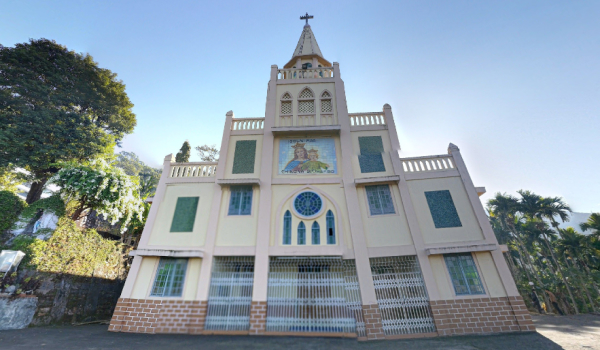
In a land area of 8,167 square kilometers, the diocesan territory covers East and West Garo Hills districts and the part of Goalpara district in south of Brahmaputra River in Megahalaya.
Tura is the biggest town in the diocese. William Nagar and Resubelpara are the other important towns in the diocese.
In 2017, the total population in the diocesan area was 1,144,167. Garos, Rabhas, Koch and Hajong are the major ethnic groups.
Garo, Rabha, Assamese, Khasi, Bengali and English are the languages used in the diocesan territory.
Although Christianity took its roots in Garo Hills as early as in 1867, it was only in 1933 that Catholic missionaries began organized evangelization work. Prior to 1933, some missionaries had occasionally visited areas inhabited by the Garos. Father Rudolf Fontaine, a Salvatorian priest then residing in Guwahati, was the first Catholic priest to visit Garoland in 1913. It is recorded that during the time of the Jesuit missionaries (1914-1922), Father Carberry SJ visited Laskarpara, a village of the Garos, in 1921.
The first Garo Catholics in Garo Hills were those baptized by the Holy Cross Fathers in the present Bangladesh and then migrated to Garo Hills, especially to those villages near Baghmara. The first apostle of Garo Hills was Peter Shem Momin, a Garo who received the Catholic faith while undergoing agricultural training in Shillong. He was responsible for the early conversions at Laskarpara, Chotcholja, Damit Apal, Kharkutta and Dilma.
The first Salesian missionary to tour Garo Hills was Father Gil in 1923. Fathers Piasecki and Marmol who visited Garo Hills and also those villages on the Baghmara site via Mymensing once a year followed him.
In 1931, Msgr. L. Mathias, the then prefect apostolic of Assam, appointed Fathers Pianazzi and Rocca to work among the Garos. As they were not allowed by the government to reside in Garo Hills, they took up residence at Dhubri in 1932. In 1933, the Fathers managed to obtain permission to stay in Garo Hills and thus opened the first Catholic mission at Tura. From then on many European priests of the Salesians of Don Bosco have worked tirelessly to spread the Gospel in Garo Hills.
The missionary endeavors in Garo Hills received a great boost with the arrival of missionaries from South India. The first Indian missionaries to set foot in Garo Hills were Fathers M.P. Alexander and Mathew Elanjipuram who came to Garo Hills in 1956. Father E.O. Mathew in 1959 and Fathers George Mamalassery and George Elavankunnel in 1960 followed them. In the year 1970, the MSMHC Sisters, the Missionary Congregation of Blessed Sacrament Fathers and some diocesan priests from Changanacherry diocese volunteered to work in Garo Hills.
Bishop O. Marengo SDB, former ordinary of Dibrugarh and Tezpur, was appointed episcopal vicar in 1972. On April 7, 1973, Tura was made a diocese by detaching territories from the archdiocese of Shillong-Guwahati with Bishop Marengo as apostolic administrator. At that time, the diocese had around 40,000 Garo Catholics spread over the entire Garo Hills and the Goalpara and Kamrup districts of Assam.
In 1976, the first Garo priest Father Crispinus Rangsa from Baghmara was ordained.
Pope John Paul II relieved Bishop Marengo of the office of apostolic administrator on Feb. 8, 1979, and appointed Father George Mamalassery as the first bishop of Tura. The new bishop was consecrated on March 18, 1979.
Bishop George opened many more new parishes and built many spacious churches at key centers.
In 1987 Bishop George invited the Salesians of Don Bosco to open the much needed Catholic College at Tura to the great benefit of many Catholic boys and girls.
On June 17, 2004, Pope John Paul II nominated Father Andrew R Marak as the coadjutor bishop of Tura. He was ordained bishop on Oct. 3, 2004 at Tura.
On completion of 75 years of age on April 22, 2007, Pope Benedict XVI accepted the resignation of Bishop George, and appointed Bishop Andrew R. Marak as the Bishop of Tura. Bishop George has rendered yeoman service for well over 28 years to the people of Garo Hills both as a religious leader and a Social worker.
The villages and small towns are administered by elected local bodies called panchayats and municipalities respectively.
The diocesan area is well connected in terms of transport infrastructure by roads. The nearest airport is in Guwahati city.
The per capita income in the diocesan territory is Rs 18,274 ($394) as of January 2010. Farming is the major occupation.
Government and private operators provide extensive telecommunication facilities in the diocesan area. The diocese is well connected by local cable TV networks.
Nearly 55 percent is the literacy rate in the diocesan territory.